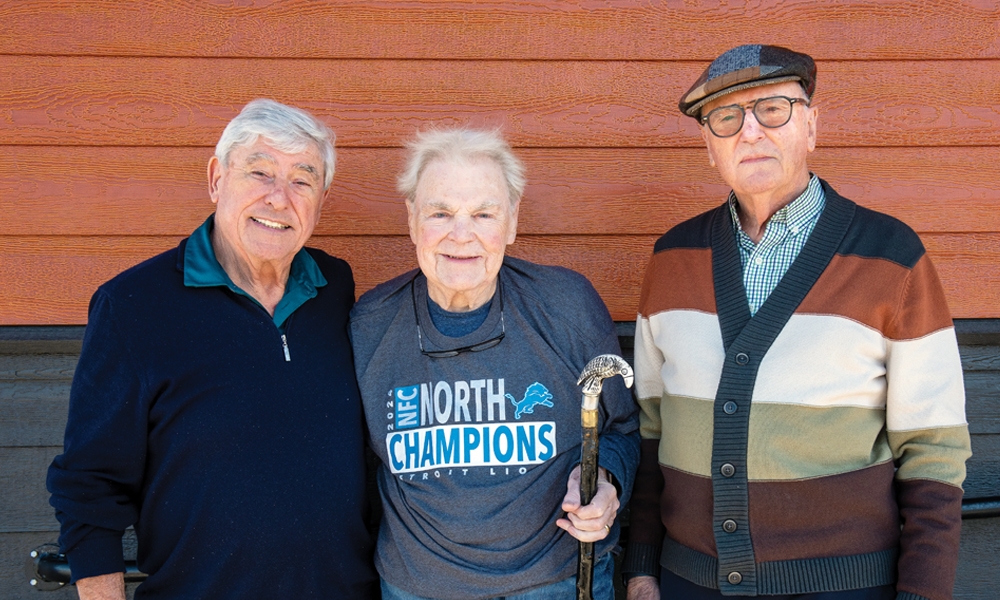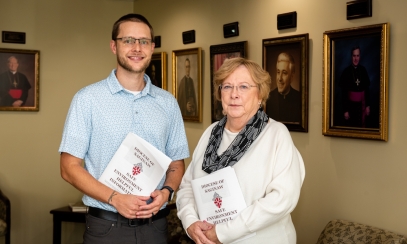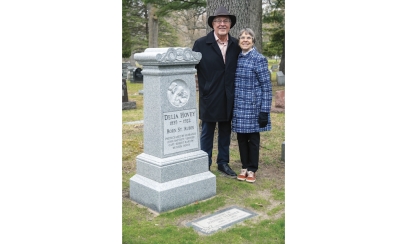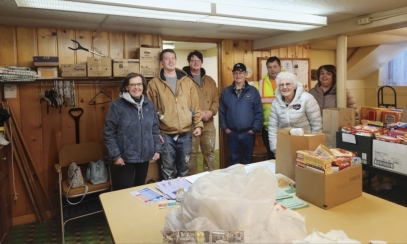
From Dublin to the Saginaw Valley
Irish Catholic physicians look back on “the best move”
Irish Catholic physicians look back on “the best move”
Inside a dimly-lit Irish pub in Saginaw, Dr. Louis Byrne recounted the story of how more than 150 Irish physicians came to the Saginaw Valley and, it may be said, changed the landscape of the medical community and beyond. Sprinkled throughout the conversation was a litany of famous Irish Catholics — politicians, writers, doctors — and their ancestral counties. Woven throughout the stories were two strong themes: pride in his beloved native land and love for his adopted home.
Inside a dimly-lit Irish pub in Saginaw, Dr. Louis Byrne recounted the story of how more than 150 Irish physicians came to the Saginaw Valley and, it may be said, changed the landscape of the medical community and beyond. Sprinkled throughout the conversation was a litany of famous Irish Catholics — politicians, writers, doctors — and their ancestral counties. Woven throughout the stories were two strong themes: pride in his beloved native land and love for his adopted home.
It began when Dr. Sean Hoban, the first of the future cohort of Irish physicians, came to Saginaw in 1959. He looked at a map and followed I-75 up from Detroit— home of the world’s richest company at the time, General Motors. He happened to pick Saginaw, wrote a letter to St. Luke’s Hospital and landed an internship.
“[The region] is a little hidden gem,” said Louis, a fourth-generation Dubliner who moved to Saginaw after completing medical school.
In 1968, Saginaw Cooperative Hospitals (SCH), a collaborative of St. Luke's, St. Mary’s and Saginaw General Hospitals, asked Dr. Hoban to recruit more Irish physicians. SCH had established one of the first family medicine residency programs in the country, and they needed to train more doctors in this emerging specialty. He and Dr. Bob Feeley, who also recruited doctors on behalf of the Daughters of Charity, did so.
Through 1973, about 40 Irish interns and more than 100 medical students came to Saginaw. Fourteen more stayed in the region, including Louis, Dr. Jim McCourt and Dr. Dermot O’Brien. They’re the last of that group of Irish physicians still living in the area. Dr. Tom O’Callaghan, Dr. Linda Ca, Dr. Patrick Canning and Dr. Pete O’Dwyer have since moved to other communities.
Recruited by Dr. Hoban, Louis immigrated to the U.S. with his wife Elizabeth in January 1970.
“I thought I landed in Siberia!” he joked.
The couple planned to stay at the Bancroft Hotel until they found housing, but the next day, Elizabeth began having back pain. Less than 36 hours after arriving in Saginaw, their first child was born.
Like Louis, Jim and Dermot had interned in Saginaw. Dermot even met his future wife Judy while interning, which impacted his decision to return to Saginaw in 1970 for a three-year family medicine residency.
“They didn’t treat you as though you were a medical student,” remarked Dermot, referring to the SCH physicians. “I loved it.” (He did, however, note that he was surprised that it’s “so flat.”)
“When I spent my summer here, [the doctors] were so engaging and so excited to get you involved,” agreed Jim, an obstetrician-gynecologist who delivered more than 5,000 babies—and was known for reciting poetry and singing to the newborns.
Louis remarked that many physicians were leaving Ireland to work elsewhere, and many of his classmates emigrated to Canada, the U.S., Australia, New Zealand and England.
“We didn’t have much opportunity in Ireland if you didn’t know anyone,” explained Jim. Ireland graduates many more doctors annually than there are job openings.
The complex political situation at the time also could make finding work in Ireland, Northern Ireland or England difficult. As someone with a Catholic surname, Louis knew he couldn’t get hired in certain places. In Michigan, however, that prejudice didn’t exist— partly, he believes, because of the success of famous Irish Catholics.
“We were glad to come here, and we were treated well,” he said.
When Dermot returned after time in Vancouver, he joined the budding family medicine training program, along with Louis and other physicians. The program included thought leaders in the family practice movement like Dr. Roy Gerard and Dr. Jim O’Brien, who did his residency in Saginaw. The two also helped start the first family medicine program at Michigan State University.
“It was challenging, because we had to be trained in a different system, but mostly everybody was very friendly, very willing to help and welcoming,” Dermot said. “That was the big key here. ... There were doctors here already who invited us into their homes, and we got along great.”
One of those doctors was Dr. George Ellis and his wife Betty, whose home was nicknamed the “Irish Embassy.” The couple hosted gatherings and even recruited physicians to stay.
“Every physician was welcome there,” Louis said, recalling the couple’s radical hospitality, gladly receiving guests with an open refrigerator and open bed.
“He and his wife were the welcoming committee,” said Father Randy Kelly, a senior priest who served from 1994 to 1996 at St. Stephen Parish, now St. Dominic Parish, where many of the Irish physicians were members.
So beloved was George that, when he was dying, Father Randy went to anoint him and pray with the family at their home. He mentioned to Betty that she could invite a few friends over to pray, too.
“When I got there, the place was packed!” Father Randy exclaimed. The whole Irish population of the region was there, it seemed.
Another two pillars of the Irish community were spouses Dr. Mary Herlihy and Dr. Michael Grant. Their impact on the St. Charles community was so great that after Michael’s death, a memorial clock was erected in the town square.
“It was comforting to have our own little Irish group,” said Jim. “Even though we were well-integrated [into the community], we stuck together. It was like a family.”
The physicians filled the need for medical care, particularly in family medicine and OB/GYN care, as Saginaw County’s population was growing.
“We opened practices that served the community,” Dermot said.
The doctors’ sense of service went beyond the medical and Saginaw community; they were also generous to their parish.
"All these Irish physicians— they’re good, practicing Catholics,” said Father Randy.
Louis also has connections to two notable Irish Catholics of the recent past. The foundress of the Sisters of Mercy, Venerable Catherine McAuley, was born near Dublin in 1778, and her first foundation for the Sisters of Mercy is in Dublin as well. Mother McAuley founded Mater Misericordiae Hospital, where Louis trained. Her great-nephew Dr. Patrick Collin was an orthopedic surgeon there and one of Louis’ clinical teachers.
Louis’s great-uncle also knew Venerable Matt Talbot, a Dublin dock worker who made a pledge to avoid alcohol for three months after 15 years as an active alcoholic. Strengthened by grace, prayer, daily Mass and asceticism, Talbot never touched alcohol for the remaining 41 years of his life. Louis added that his mother used to visit his grave at Glasnevin Cemetery to pray until his remains were moved to a tomb at Our Lady of Lourdes Church.
Of course, the most famous Irish Catholic remains St. Patrick, and one year Father Randy decided to email all the Irish names in the parish listing, asking for help with a St. Patrick’s Day party. That was the beginning of a wonderful friendship— and a very successful fundraiser.
“[They] made sure everything was paid for. It was very generous!” he said. The men agreed it was a wonderful event.
Louis also wrote a letter to the president of Ireland about the event, and she responded with a harp— the proper symbol of Ireland— on her stationary.
“She wished us immigrants and all people peace and goodwill,” Louis recalled.
At the University College of Dublin, each of them were trained to discuss one’s spiritual well-being, particularly with patients nearing death.
“I would talk to them about their faith and, if they’re in spiritual turmoil, offer to find help,” explained Dermot, adding that this could be the hospital chaplain, a priest, pastor or other faith leader. “You’re trained in Ireland to ask the question. ... That’s very important.”
The three doctors agree that they have seen this approach help both the patient and their family.
While Irish medical students no longer come to Saginaw for medical school, residencies or training, physicians from the Philippines, India, Pakistan and other regions continue to fill the need for care. And the trio of Irish physicians in Saginaw remain grateful for the welcoming spirit of the region.
Each of them agreed with Jim’s simple sentiment: “It was the best move I ever made."



